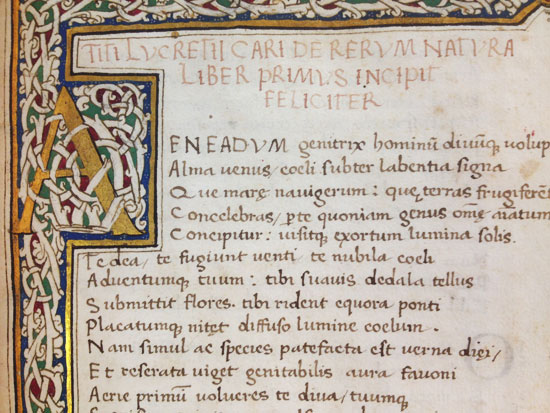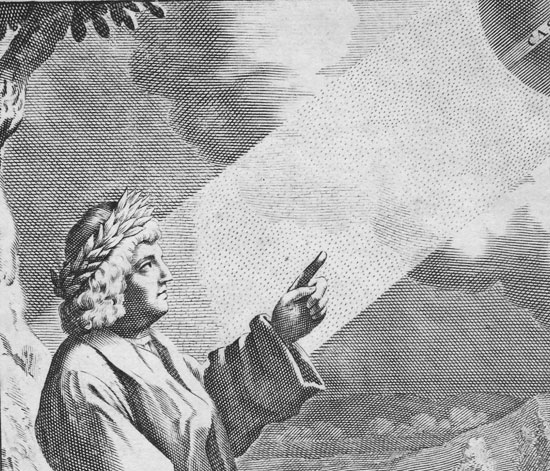This granular life (2)
Read the first part of the article
Evidence for the atomic nature of matter accumulated over centuries, much of it from chemistry. Chemical substances are made up of combinations of a few elements and are formed by proportions (of weight) given by whole numbers. Chemists have constructed a way of thinking about substances as composed of molecules made up of fixed combinations of atoms. Water, for example – H2O – is composed of two parts hydrogen and one part oxygen.

But these were only clues. At the beginning of the previous century, numerous scientists and philosophers still did not consider the atomic hypothesis to be credible. Among them was the renowned physicist and philosopher Ernst Mach, whose ideas on space would come to have great importance for Einstein. At the end of a lecture by Ludwig Boltzmann at the Imperial Academy of Sciences in Vienna, Mach publicly declared: “I do not believe that atoms exist!”
This was in 1897. Many, like Mach, understood chemical notation only as a conventional method of summarizing laws of chemical reactions – not as evidence that there actually were molecules of water composed of two atoms of hydrogen and one of oxygen. You can’t see atoms, they would say. Atoms will never be seen, they would say. And then, they asked, how big would an atom be? Democritus could never measure the size of his atoms.
But somebody else could. The definitive proof of the “atomic hypothesis” had to wait until 1905. It was found by a rebellious 25-year-old who had studied physics but had not been able to find employment as a scientist and was making ends meet by working in the patent office in Bern. There were three articles that he sent to the most prestigious physics journal of the time, the Annalen der Physik. The first of these articles contained the definitive proof that atoms exist and calculated their dimensions, solving the problem posed by Leucippus and Democritus 23 centuries earlier. The name of this 25-year-old, obviously, is Albert Einstein.
His method is surprisingly simple. Anyone could have arrived at it, from the time of Democritus onward, if he had Einstein’s acumen, and a sufficient mastery of mathematics to make what was not an easy calculation. The idea goes like this: if we attentively observe very small particles, such as a speck of dust or a grain of pollen, suspended in still air or in a liquid, we see them tremble and dance. Pushed by this trembling, they move, randomly zigzagging, and so they drift slowly, gradually moving away from their starting point. This motion of particles in a fluid is called Brownian motion, after Robert Brown, a biologist who described it in detail in the 19th century. It is as if the small particle is receiving blows randomly from each side. No, it isn’t “as if” it were being hit; it really is hit. It trembles because it is struck by the individual molecules of air, which collide with the particle, at times from the right and at times from the left.
It is possible to work back from the amount of movement of the granule, which can be observed, to the dimensions of the molecules.
The subtle point is that there is an enormous number of molecules of air. On average, as many hit the granule from the left as from the right. If the air’s molecules were infinitely small and infinitely numerous, the effect of the collisions from right and left would balance at each instant, and the granule would not move. But the finite size of the molecules, and the fact that these are present in finite rather than infinite number, causes there to be fluctuations (this is the key word). That is to say, the collisions never balance out exactly; they balance out only on average. Imagine for a moment the molecules were very few in number and large in size. The granule would clearly receive a blow only occasionally: now one on the right, then one on the left. Between one collision and the other, it would move here and there to a significant degree, like a football kicked by boys running around a playing field. The smaller the molecules, the shorter the interval between collisions, the better that hits from different directions would cancel out one another, and the less the granule would move.

It is possible, with a little mathematics, to work back from the amount of movement of the granule, which can be observed, to the dimensions of the molecules. Einstein does this at the age of 25. From observations of granules drifting in fluids, from the measurement of how much these ‘drift’ – that is, move away from a position – he calculates the dimensions of Democritus’s atoms, the elementary grains of which matter is made. Einstein provides, after 2,300 years, the proof of the accuracy of Democritus’s insight: matter is granular.
“Sublime Lucretius’s work will not die, until the day the world itself passes away”, wrote Ovid. The loss of the works of Democritus in their entirety is an intellectual tragedy. We have been left with all of Aristotle, by way of which Western thought reconstructed itself, and nothing by Democritus.
The closure of the ancient schools such as those of Athens and Alexandria, and the destruction of all the texts not in accordance with Christian ideas, was vast and systematic, at the time of the brutal anti-pagan repression following the edicts of Emperor Theodosius, which in 390–391 CE declared that Christianity was to be the only and obligatory religion of the empire. Plato and Aristotle, pagans who believed in the immortality of the soul or in the existence of a Prime Mover, could be tolerated by a triumphant Christianity. Not Democritus.
But a text survived the disaster and has reached us in its entirety. Through it, we know a little about ancient atomism, and above all we know the spirit of that science. It is the poem De Rerum Natura (The Nature of Things, or On the Nature of the Universe), by the Latin poet Lucretius.
Lucretius adheres to the philosophy of Epicurus, a pupil of a pupil of Democritus. Epicurus is interested more in ethical than scientific questions, and does not have Democritus’s depth. He sometimes translates Democritean atomism a little superficially. But his vision of the natural world is substantially that of the great philosopher of Abdera. Lucretius decants in verse the thought of Epicurus and the atomism of Democritus, and in this way a part of this profound philosophy was saved from the intellectual catastrophe of the Dark Ages. Lucretius sings of atoms, the sea, the sky, of nature. He expresses in luminous verse philosophical questions, scientific ideas, refined arguments: “I will explain by what forces nature steers the courses of the Sun and the journeys of the Moon, so that we shall not suppose that they run their yearly races between the heaven and Earth of their own free will…”
The beauty of the poem lies in the sense of wonder that pervades the vast atomistic vision. The sense of the profound unity of things, derived from the knowledge that we are all made of the same substance as are the stars, and the sea: “We are all sprung from heavenly seed. All alike have the same father, from whom all-nourishing mother Earth receives the showering drops of moisture. Thus fertilized, she gives birth to smiling crops and lusty trees, to mankind and all the breeds of beasts. She is that yields the food on which they all feed their bodies, lead their joyous lives and renew their race.”
There is a deep acceptance of the life of which we are an integral part: “Do you not see that nature is clamoring for two things only, a body free from pain, a mind released from worry and fear for the enjoyment of pleasurable sensations?”
And there is a serene acceptance of the inevitability of death.

Lucretius’s text, forgotten for centuries, was rediscovered in January 1417 by the humanist Poggio Bracciolini, in the library of a German monastery. Poggio had been the secretary of many popes and was a passionate hunter of ancient books, in the wake of the celebrated rediscoveries made by Francesco Petrarch. His rediscovery of a text by Quintilian modified the course of the study of law throughout the faculties of Europe; his discovery of the treatise on architecture by Vitruvius transformed the way in which fine buildings were designed and constructed. But his triumph was rediscovering Lucretius.
The actual codex found by Poggio has been lost, but the copy made by his friend Niccolò Niccoli (now known as the Codex Laurenziano 35.30) is still preserved in its entirety in the Biblioteca Laurenziana in Florence. The ground was already surely prepared for something new when Poggio gave Lucretius’ book back to humanity. The rediscovery of De Rerum Natura had a profound effect upon the Italian and European Renaissance, and its echo resounds, directly or indirectly, in the pages of authors ranging from Galileo to Johannes Kepler, and from Francis Bacon to Niccolò Machiavelli. In William Shakespeare’s Romeo and Juliet, a century after Poggio, atoms make a delightful appearance:
“Mercutio: O, then I see Queen Mab hath been with you.
She is the fairies’ midwife, and she comes
In shape no bigger than an agate-stone
On the fore-finger of an alderman,
Drawn with a little team of atomies
Athwart men’s noses as they lie asleep.”
From there, the influence of Lucretius extended to Isaac Newton, John Dalton, Baruch Spinoza, Charles Darwin, all the way to Einstein. The very idea that the existence of atoms is revealed by the Brownian motion of minute particles immersed in a fluid can be traced back to Lucretius.
Here is a passage in which Lucretius provides a “living proof” of the notion of atoms: “Observe what happens when sunbeams are admitted into a building and shed light on its shadowy places. You will see a multitude of tiny particles mingling in a multitude of ways in the empty space within the light of the beam, as though contending in everlasting conflict, rushing into battle rank upon rank with never a moment’s pause in a rapid sequence of unions and disunions. From this you may picture what it is for the atoms to be perpetually tossed about in the illimitable void… their dancing is an actual indication of underlying movements of matter that are hidden from our sight. There you will see many particles under the impact of invisible blows, changing their course and driven back upon their tracks, this way and that, in all directions. You must understand that they all derive this restlessness from the atoms. It originates with the atoms, which move of themselves.”
Einstein resuscitated the proof presented by Lucretius, and probably first conceived of by Democritus, and translated it into mathematical terms, thus managing to calculate the size of the atoms.

The Catholic Church attempted to stop Lucretius: in the Florentine Synod of December 1516, it prohibited the reading of Lucretius in schools. In 1551, the Council of Trent banned his work. But it was too late. An entire vision of the world that had been swept away by medieval Christian fundamentalism was re-emerging in a Europe that had reopened its eyes. It was not just the rationalism, atheism and materialism of Lucretius that were being proposed in Europe. It was not merely a serene glance on the beauty of the world. It was also an articulate and complex structure of thinking about reality, a new mode of thinking, radically different from what had been for centuries the mind-set of the Middle Ages.
There is a feeling of deep universalism, in the wake of the words of Democritus: “To a wise man, the whole Earth is open, because the true country of a virtuous soul is the entire universe.”
The simple idea of the finite divisibility of things – the granular quality of the world – is the idea that stops the infinite between our fingers.
There is, too, the ambition of being able to think about the world in simple terms. Of being able to investigate and understand the secrets of nature. To know more than our parents. There are extraordinary conceptual tools on which Galileo, Kepler and Newton will build: the idea of free and rectilinear motion in space; the idea of elementary bodies and their interactions, out of which the world is constructed; the idea of space as a container of the world.
And there is the simple idea of the finite divisibility of things – the granular quality of the world. It is the idea that stops the infinite between our fingers. This idea is at the root of the atomic hypothesis, but it has returned with augmented force in quantum mechanics. Energy can move only in discrete units, and we might yet find that space and time are likewise composed of their own fundamental units. Importing the atomic philosophy of Democritus into modern physics might be essential for reconciling general relativity (which assumes a continuous reality) with quantum mechanics (which very much does not).
Merging relativity and quantum mechanics into a new theory of quantum gravity will lift physics to the next level, and will also achieve an appealing historical closure. Einstein’s paper on Brownian motion was inspired by atomism, whereas his theory of relativity emerged from the anti-atomic philosophy of Mach. With quantum gravity, the last barrier will fall.
yogaesoteric
January 14, 2018
